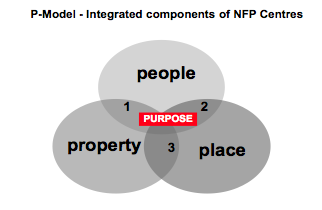3 P’S OF NONPROFIT CENTRES
Having managed two very different youth focused not-for-profit centres (NFP Centres), one in the UK and one in Australia, for the past 15 years, I was inspired to seek out a better understanding of the critical success factors inherent in models that have performed well in their development and ongoing adaptability, within their local communities. Australia is slowly gaining momentum in the NFP Centre space and an Australian-American Fulbright Scholarship provided the opportunity for me to be based at the Nonprofit Centers Network (NCN), to explore ten of those centres in North America and Canada. Whilst this exploratory research revealed a burgeoning ecosystem of complex arrangements of social purpose real estate, elaborate funding and financing tapestries and interpersonal and professional multidisciplinary stakeholder relationships, driven by an array of missions and visions, the study highlighted clear and apparent themes throughout the NFP Centre’s. The shared experiences that arose out of the discursive interviews with the ten leaders of the NFP Centres provided a conceptual framework from which to create a set of organizing principles that seemed to offer an explanatory model that has utility and application, regardless of purpose, client population, demography and geography. As a result, the P-Model emerged and comprises three primary intersecting and integrated components of people,property and place, that coalesce to strengthen the purpose underpinning NFP Centre’s.
 The P-Model represents the marriage between people (human and social capital), property (social infrastructure and capital resources) and place (community and location) that underpins the concept of NFP (human service) Centre’s. These elements combine to galvanize the purpose of the overall mission and vision within the co-located model and the purpose in turn, creates cohesion and animates the NFP organizations to produce amplified benefits for their end service users. In order for the P-Model to operate effectively, there must be both integration and interaction between each of the components. The challenge for leaders of NFP Centre’s therefore, is to invest adequate resources in terms of time and money to do this effectively. There are however, a range of risks at the interface and within the inter-space of each of the elements that must be successfully tackled and overcome in order to achieve an efficient and effective model. Some of the following challenges will be familiar to those involved in NFP Centre development and sustainability:
The P-Model represents the marriage between people (human and social capital), property (social infrastructure and capital resources) and place (community and location) that underpins the concept of NFP (human service) Centre’s. These elements combine to galvanize the purpose of the overall mission and vision within the co-located model and the purpose in turn, creates cohesion and animates the NFP organizations to produce amplified benefits for their end service users. In order for the P-Model to operate effectively, there must be both integration and interaction between each of the components. The challenge for leaders of NFP Centre’s therefore, is to invest adequate resources in terms of time and money to do this effectively. There are however, a range of risks at the interface and within the inter-space of each of the elements that must be successfully tackled and overcome in order to achieve an efficient and effective model. Some of the following challenges will be familiar to those involved in NFP Centre development and sustainability:
1. People and Property – The inter-space between people and property involves the functionality and comfort of the building to enhance the service provision delivered by the NFP tenants within the building and ultimately the end users of the building. Dysfunction in this realm includes poor design and layout, irregularities and problems with basic services and amenities, lack of adequate parking, inadequate and limited common areas and cramped working spaces. There is a balance that needs to be achieved between large cavernous common spaces and small inadequate working spaces that heavily weighted in either direction, pose challenges of proportion to their usefulness. In short, the building must be fit for its intended purpose, as failure in this interface can strain relationships between the landlord / tenant (lack of quality space to deliver services effectively and efficiently), tenant / tenant (pressure and competition for shared amenities, confidential meeting rooms and training spaces), tenant / service user (disruption in response time and appropriate service interventions due to competitive room bookings, lack of confidential spaces and inaccessible computer and telephone resources).
2. People and Place – The inter-space between people and place refers to the local community and the service users from that community who access the NFP Centre. Adverse affects within this space involve lack of community consultation to get the local community ‘buy-in’ for the NFP Centre in the first place and lack of ongoing accountability to and inclusiveness with the local community that are critical maintaining interest and support. Risks associated with lack of consultation and maintaining the involvement and interest of the local community may present threats to its ongoing viability as human service centre’s in particular, are primarily located to serve the needs of that community. It is inordinately difficult to reverse and invigorate local community perception on the usefulness of the NFP Centre within their community if it does not feel relevant and useful to the population it is intended to serve.
3. Place and Property – The inter-space between place and property pertains to the relevance and appropriateness of the location of the building and its capacity to respond effectively to local community needs. Limited appropriate building availability, particularly in the current climate of competitive and expensive real estate, can often overshadow the prevailing factors required for optimum service provision required to satisfy the needs and accessibility of client populations. If the building is inaccessible by foot or public transport and fails to provide a sufficient perception of usefulness and value for its intended service users, it risks becoming a failed venture. One example of this is where NFP Centres established in low socio-economic areas specifically located to service disadvantaged communities may experience gentrification in their local surroundings as increasingly expensive real estate pushes out targeted communities, rendering the centre inaccessible by default.
The P-Model is able to provide a framework to assist in the planning process of emerging NFP Centres, as it offers a basis to articulate the combined elements affecting the model, all of which can pose challenges for proposed and existing NFP Centres. Whilst acknowledging the unique trajectories of all NFP Centres, regardless of themes and locations, it is useful to consider the three interlinked elements of property, people and place to centre the social purpose of the NFP Centre.







